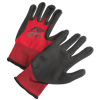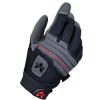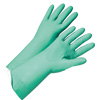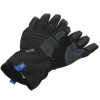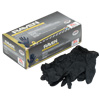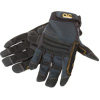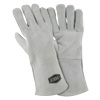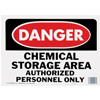
Hand Protection & Glove Standards

The Occupational Safety and Health Administration (OSHA) requires workers to have hand and arm protection when exposed to hazards "that cannot be completely eliminated through other means." OSHA wants to prevent injuries such as:
- Skin absorption of harmful substances
- Chemical or thermal burns
- Electrical dangers
- Bruises, abrasions, and cuts
- Punctures
- Fractures and amputations
Protective gloves should be selected based on the type of work and the possible hazards. Care must be taken to ensure the right gloves are being used. Gloves designed for one type of hazard may not protect against another, even though they may look similar.
Glove Ratings & Standards
To help choose the gloves that will properly protect against workplace hazards, the American National Standard Institute (ANSI)/ISEA released Hand Protection Selection Criteria, known as ANSI/ISEA 105-2011. It provides a "Numeric-scale method for manufacturers to rate their products against certain contaminants and exposures."
Types of Gloves
Gloves are designed to protect against hazards related to chemicals, abrasions, cuts, and temperature. The most common types of protective gloves used in the workplace include:
- Disposable Gloves - protect against contamination, used in janitorial, food service, and healthcare settings. They can be made of nitrile, latex, polyurethane, or bi-polymer materials.
- Cotton Gloves - all-purpose work glove, improves grip, protects against dirt, and insulates. Available in different weights and blends like jersey cotton, coated cotton, terry, and more.
- Leather Gloves - protect against abrasions.
Specific Protection
Not all gloves protect equally. It's important to choose a glove that is designed to protect against specific workplace hazards.
-
Anti-Vibration Gloves
Long exposure to vibration can result in injuries like carpal tunnel. Supply protective anti-vibration gloves to anyone who works with power tools like lawn mowers, trimmers, sanders, saws, grinders, etc. These specialty gloves reduce impact and shock hazards and hand fatigue.
-
Chemical-Resistant Gloves
Protect workers who come in contact with corrosive materials, oils, and chemicals. Typically made of rubber, neoprene, PVC, PVA, nitrile, vinyl, etc. When selecting chemical-resistant gloves, you should consult the manufacturers' recommendations, and the chemical's Safety Data Sheet (SDS) to get the best protection.
Chemical Glove Options
E = EXCELLENT VG = Very Good G = Good F = Fair H = High M = Medium L = Low $$$ = Premium $$ = Standard $=Value
COATINGS Dry Grip Wet Grip Oil Grip Abrasion Resistance Tactility Comfort Permeability Cost NITRILE COATINGSFLAT
Smooth, nonporous coating which provides high chemical and abrasion resistance.Dry GripE Wet GripF Oil GripF Abrasion ResistanceE TactilityVG ComfortVG PermeabilityL Cost$$ COATINGSSPONGE
Flexible, porous and tacky coating for better grip. Slow water permeation.Dry GripE Wet GripVG Oil GripVG Abrasion ResistanceVG TactilityG ComfortG PermeabilityM Cost$$$ COATINGSFOAM
Flexible, thin, porous coating. Fast water permeation for excellent grip. Draws liquid away from surface. Breathable.Dry GripG Wet GripE Oil GripE Abrasion ResistanceG TactilityVG ComfortVG PermeabilityH Cost$$$ POLYURETHANE COATINGSStrong, durable, lightweight and breathable. Provides flexibility and high resistance to abrasion. Dry GripVG Wet GripG Oil GripVG Abrasion ResistanceVG TactilityE ComfortE PermeabilityH Cost$ LATEX COATINGSFlexible and comfortable. Less resistant to abrasion, tearing or cutting. Provides resistance to heat. Dry GripVG Wet GripF Oil GripF Abrasion ResistanceVG TactilityF ComfortF PermeabilityL Cost$$$ BI-POLYMER COATINGSFlexible, thin, lightweight. High permeability and breathability. Low resistance to abrasion Dry GripVG Wet GripE Oil GripE Abrasion ResistanceF TactilityG ComfortVG PermeabilityH Cost$$$
Cut-Resistant Gloves
No safety glove is 100% "cut-proof" but you can provide extra safety with cut-resistant gloves.
There are two standards for cut resistance: the American standard, ANSI/ISEA 105 and the European standard, EN388. The two rating systems are not interchangeable. The ANSI and EN standards use two different test methods each based on its own criteria. The tests and results are so different that there is no way to convert test results between the two systems.
ANSI Glove Testing
The ANSI performance-based rating system uses the results of laboratory tests from published industry-accepted standard test methods written by ASTM, EN, ISO, or ANSI. To measure cut resistance, a straight-edge razor is used as weight is gradually increased. The blade is drawn back and forth across a swatch of the glove material, until it breaks.
| ANSI CUT LEVEL | WEIGHT IN GRAMS TO CUT THROUGH |
|---|---|
| ANSI CUT LEVELLevel 0 | WEIGHT IN GRAMS TO CUT THROUGH< 200 g |
| ANSI CUT LEVELLevel 1 | WEIGHT IN GRAMS TO CUT THROUGH≥ 200 g |
| ANSI CUT LEVELLevel 2 | WEIGHT IN GRAMS TO CUT THROUGH≥ 500 g |
| ANSI CUT LEVELLevel 3 | WEIGHT IN GRAMS TO CUT THROUGH> 1,000 g |
| ANSI CUT LEVELLevel 4 | WEIGHT IN GRAMS TO CUT THROUGH≥ 1,500 g |
| ANSI CUT LEVELLevel 5 | WEIGHT IN GRAMS TO CUT THROUGH≥ 3,500 g |
For abrasion testing, the ANSI rating considers the number of cycles needed to wear through the glove material using a 500 gram load for level 0-3 and a 1,000 gram load for levels 4-6.
| LEVEL (500G LOAD) | ABRASION CYCLES TO FAIL |
|---|---|
| LEVEL (500G LOAD)Level 0 | ABRASION CYCLES TO FAIL< 100 cycles |
| LEVEL (500G LOAD)Level 1 | ABRASION CYCLES TO FAIL≥ 100 cycles |
| LEVEL (500G LOAD)Level 2 | ABRASION CYCLES TO FAIL≥ 500 cycles |
| LEVEL (500G LOAD)Level 3 | ABRASION CYCLES TO FAIL≥ 1,000 cycles |
| LEVEL (1000G LOAD) | ABRASION CYCLES TO FAIL |
| LEVEL (1000G LOAD)Level 4 | ABRASION CYCLES TO FAIL≥ 3,000 cycles |
| LEVEL (1000G LOAD)Level 5 | ABRASION CYCLES TO FAIL≥ 10,000 cycles |
| LEVEL (1000G LOAD)Level 6 | ABRASION CYCLES TO FAIL≥ 20,000 cycles |
EN Glove Testing
The EN388 Standard used in the European Union relies on a "coup test" that involves a rotating circular blade and a fixed weight. The numeric rating is based on a ratio of how many cycles it takes the blade to cut the material.
Improve Safety
Generally, with ANSI rating system, the higher the number, the stronger level of protection. However, you must also consider mobility and comfort when choosing the right glove for the job. Cut-resistant gloves are typically made from metal mesh, Kevlar ®, and spectra fiber.
It is important to remember cut resistance is not the same as cut-proof. Cut-resistant gloves do not protect from rotating blades, and serrated blades will catch on knitted materials.
Shop Gloves & Safety Equipment
NOTE: This information is a summary interpretation and was prepared as general reference material only. This summary is not authoritative as laws can be amended over time. For specific compliance requirements and updates, please refer to the actual code language and the statute or legal counsel.

